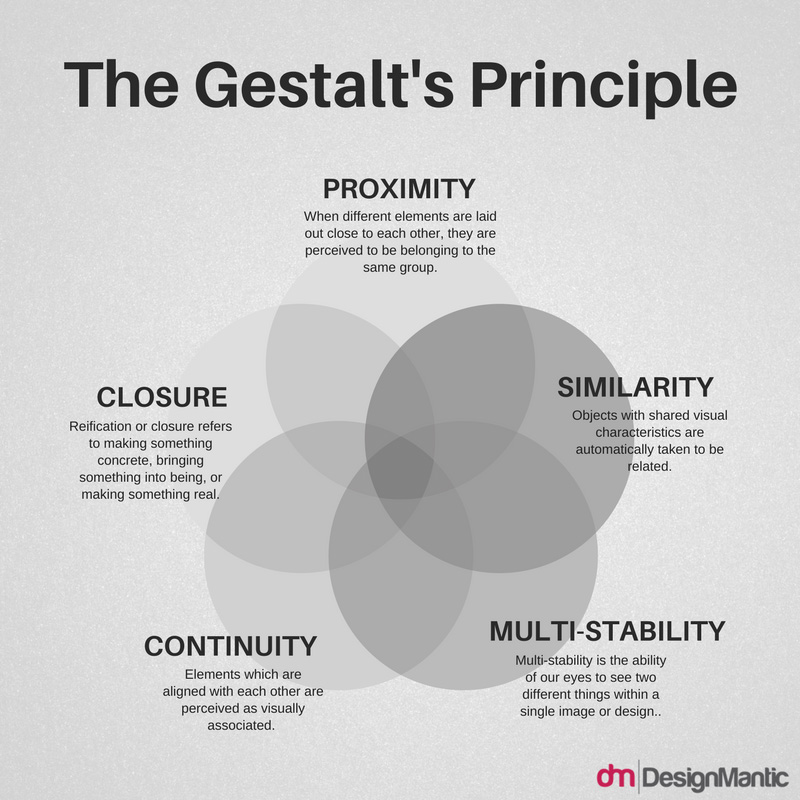Describe the Basic Tenets of Gestalt Psychology
Do you want unlimited and ad-free access. Gestalt psychology was founded on works by Max Wertheimer Wolfgang Köhler and Kurt Koffka.

Gestalt Psychology Norulhuda Ismail
To illustrate each Gestalt Principle weve selected a great Dribbble shot.

. Through Gestalt psychology we are encouraged to see and treat the mind and behavior as a whole. Gestalt psychology explains human perception using different laws and is also a branch of psychotherapy. Gestalt psychology can be defined as a school of thought that emerged in the early twenties and believes that the whole of an object or a scene is greater and more important than its components.
Find out more Through this concept we are encouraged to see and treat the mind and behavior as a whole. What are the basic principles of Gestalt psychology and why was it important in early life of psychology. In terms of applicationswhat would make humanistic psychology appealing.
And having a solid understanding of how these principles work will help you in three ways. The law of proximity The law of similarity The law of continuity The law of closure The law of connectedness The law of proximity asserts that when objects or shapes are close together we tend to perceive them as a group. After all we have a lot to take in.
This includes the patterns on the wall the details in the floor and any other individual objects that you could turn your focus to at any given moment. The connection between certain aspects of Gestalt psychology and principles and terms of physics reflects ____. The Zeitgeist in physics at the time Gestalt psychology was founded was.
This is what allows us to create meaning in a complex and chaotic world. The five principles of Gestalt psychology are. Observing the whole helps us find order in.
The psychologist who most directly influenced the basic tenets of Gestalt psychology was Ebbinghaus. Describe the main factors of humanistic psychology. Köhlers training in physics.
Compare and contrast their views with those of their contemporaries such as psychoanalytic. Gestalt psychology can be defined as a school of thought that emerged in the early twenties and believes that the whole of an object or a scene is greater and more important than its components. The fundamental law that governs a Gestalt principle is that we tend to order our experience in a manner thats regular orderly and recognizable.
Feel free to use the clickable menu to skip to a Gestalt Principle that piques your interest. Similarity continuation closure proximity figureground and symmetry order also called prägnanz. Psychoanalysis is a psychological theory initially developed by Sigmund Freud.
From several different perspectives. There are six individual principles commonly associated with gestalt theory. Gestalt psychology is based on understanding the whole behavioral phenomenon instead of analyzing the individual components of behavior.
The first was the University Standard acquisition of viewpoints from European perspectives. In the following article we take a closer look at Gestalt psychologys theory and its 6 principles or laws on perception. The individual parts tend to be grouped together in our minds.
Now lets explore each of these principles in detail. Psychology developed in the US. 13 Gestalt principles proximity similarity figure-ground continuity closure and connection describe how humans perceive visuals in connection with different objects and environments.
There are also some additional newer principles sometimes associated with gestalt such as common fate. Gestalt psychologists looks at the way that our mind recognizes forms and patterns. The word Gestalt roughly translates to whole a major emphasis of Gestalt psychology deals with the fact that although a sensory experience can be broken down into individual parts how those parts relate to each other as a whole is often what the individual responds to in perception.
The word Gestalt roughly translates to whole a major emphasis of Gestalt psychology deals with the fact that although a sensory experience can be broken down into individual parts how those parts relate to each other as a whole is often what the individual responds to in perception. Sometimes referred to as the Law of Simplicity the theory proposes that the whole of an object or scene is more important than its individual parts. Describe the basic tenets of Gestalt psychology The word Gestalt roughly translates to whole a major emphasis of Gestalt psychology deals with the fact that although a sensory experience can be broken down into individual parts how those parts relate to each other as a whole is often what the individual responds to in perception.
The 5 Gestalt Principles well take a look at are. Max Wertheimer is the founder of Gestalt psychology while Fritz Perls established the Gestalt therapy practice. The laws of proximity closure.
The first was the University Standard acquisition of viewpoints from European perspectives. Basic principles of Gestalt psychology Psychology developed in the US. Think about everything that you can see around you right now.
From several different perspectives. Gestalt psychology is based on understanding the whole behavioral phenomenon instead of analyzing the individual components of behavior.

Visual Grouping Principles Have Been Invented By Gestalt Psychologists And Are Based On Human S Innate Ability To Principles Principles Of Design Design Rules

Gestalt Theory In Logo Design Logo Geek

Gestalt Psychology Definition Principles Examples Simply Psychology
No comments for "Describe the Basic Tenets of Gestalt Psychology"
Post a Comment